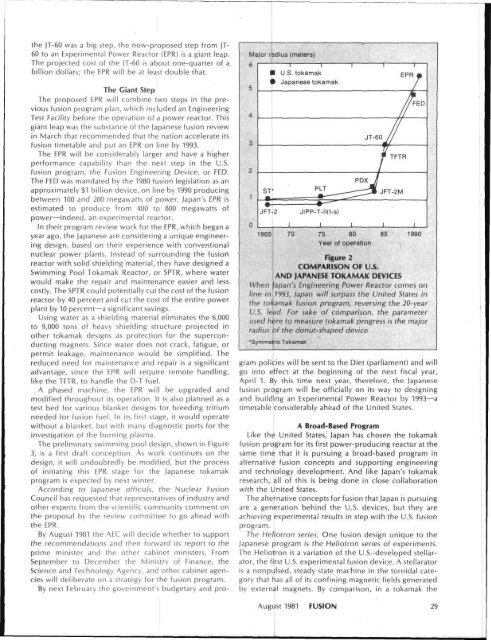Exclusive Interview with Shuttle Pilot Robert Crippen
Exclusive Interview with Shuttle Pilot Robert Crippen
Exclusive Interview with Shuttle Pilot Robert Crippen
You also want an ePaper? Increase the reach of your titles
YUMPU automatically turns print PDFs into web optimized ePapers that Google loves.
the JT-60 was a big step, the now-proposed step from JT-60 to an Experimental Power Reactor (EPR) is a giant leap.The projected cost of the JT-60 is about one-quarter of abillion dollars; the EPR will be at least double that.The Giant StepThe proposed EPR will combine two steps in the previousfusion program plan, which included an EngineeringTest Facility before the operation of a power reactor. Thisgiant leap was the substance of the Japanese fusion reviewin March that recommended that the nation accelerate itsfusion timetable and put an EPR on line by 1993.The EPR will be considerably larger and have a higherperformance capability than the next step in the U.S.fusion program, the Fusion Engineering Device, or FED.The FED was mandated by the 1980 fusion legislation as anapproximately $1 billion device, on line by 1990 producingbetween 100 and 200 megawatts of power. Japan's EPR isestimated to produce from 400 to 800 megawatts ofpower—indeed, an experimental reactor.In their program review work for the EPR, which began ayear ago, the Japanese are considering a unique engineeringdesign, based on their experience <strong>with</strong> conventionalnuclear power plants. Instead of surrounding the fusionreactor <strong>with</strong> solid shielding material, they have designed aSwimming Pool Tokamak Reactor, or SPTR, where waterwould make the repair and maintenance easier and lesscostly. The SPTR could potentially cutjthe cost of the fusionreactor by 40 percent and cut the cost of the entire powerplant by 10 percent—a significant savings.Using water as a shielding material eliminates the 6,000to 9,000 tons of heavy shielding structure projected inother tokamak designs as protection for the superconductingmagnets. Since water does not crack, fatigue, orpermit leakage, maintenance would be simplified. Thereduced need for maintenance and repair is a significantadvantage, since the EPR will require remote handling,like the TFTR, to handle the D-T fuel.A phased machine, the EPR will be upgraded andmodified throughout its operation. It is also planned as atest bed for various blanket designs for breeding tritiumneeded for fusion fuel. In its first stage, it would operate<strong>with</strong>out a blanket, but <strong>with</strong> many diagnostic ports for theinvestigation of the burning plasma.The preliminary swimming pool design, shown in Figure3, is a first draft conception. As work continues on thedesign, it will undoubtedly be modified, but the processof initiating this EPR stage for the Japanese tokamakprogram is expected by next winter.According to Japanese officials, the Nuclear FusionCouncil has requested that representatives of industry andother experts from the scientific community comment onthe proposal by the review committee to go ahead <strong>with</strong>the EPR.By August 1981 the AEC will decide whether to supportthe recommendations and then forward its report to theprime minister and the other cabinet ministers. FromSeptember to December the Ministry of Finance, theScience and Technology Agency, and other cabinet agencieswill deliberate on a strategy for the fusion program.By next February the government's budgetary and programpolicies will be sent to the Diet (parliament) and willgo into effect at the beginning of the next fiscal year,April 1. By this time next year, therefore, the Japanesefusion program will be officially on its way to designingand building an Experimental Power Reactor by 1993—atimetable considerably ahead of the United States.A Broad-Based ProgramLike the United States,' Japan has chosen the tokamakfusion program for its first power-producing reactor at thesame time that it is pursuing a broad-based program inalternative fusion concepts and supporting engineeringand technology development. And like Japan's tokamakresearch, all of this is being done in close collaboration<strong>with</strong> the United States.The alternative concepts for fusion that Japan is pursuingare a generation behind the U.S. devices, but they areachieving experimental results in step <strong>with</strong> the U.S. fusionprogram.The Heliotron series. One fusion design unique to theJapanese program is the Heliotron series of experiments.The Heliotron is a variation of the U.S.-developed stellarator,the first U.S. experimental fusion device. A stellaratoris a nonpulsed, steady state machine in the toroidal categorythat has all of its confining magnetic fields generatedby external magnets. By comparison, in a tokamak theAugust 1981 FUSION 29
















